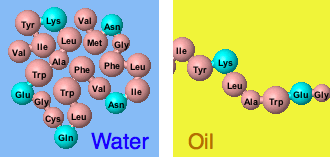Sandbox WWC6
From Proteopedia
(Difference between revisions)
| Line 1: | Line 1: | ||
== Function == | == Function == | ||
| - | '''Alpha-hemolysin''' [https://en.wikipedia.org/wiki/Hemolysin#.CE.B1-hemolysin] is a toxin secreted by Staphylococcus aureus as a pore-forming heptamer that binds to eukaryotic cell membranes. This protein belongs to a family of | + | '''Alpha-hemolysin''' [https://en.wikipedia.org/wiki/Hemolysin#.CE.B1-hemolysin] is a toxin secreted by Staphylococcus aureus as a pore-forming heptamer that binds to eukaryotic cell membranes. This protein belongs to a family of bacterial exotoxins[http://www.uniprot.org/uniprot/P09616]. The primary function of alpha-hemolysin is cytolytic, and is achieved by the release of cytosolic K<sup>+</sup> ions from the through the hydrophilic, transmembrane portion of the beta-barrel pore[http://www.sciencedirect.com/science/article/pii/S0041010101001532]. |
<applet load='1pgb' size='350' frame='true' align='right' caption='1pgb' scene='Insert optional scene name here' /> | <applet load='1pgb' size='350' frame='true' align='right' caption='1pgb' scene='Insert optional scene name here' /> | ||
Revision as of 17:48, 15 April 2016
Function
Alpha-hemolysin [1] is a toxin secreted by Staphylococcus aureus as a pore-forming heptamer that binds to eukaryotic cell membranes. This protein belongs to a family of bacterial exotoxins[2]. The primary function of alpha-hemolysin is cytolytic, and is achieved by the release of cytosolic K+ ions from the through the hydrophilic, transmembrane portion of the beta-barrel pore[3].
|
| Amino Terminus | Carboxy Terminus |
Let us color the two main forms of regular in this protein. Alpha Helices appears in red, Beta Strands in yellow.

